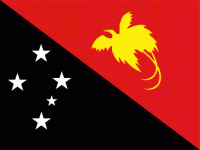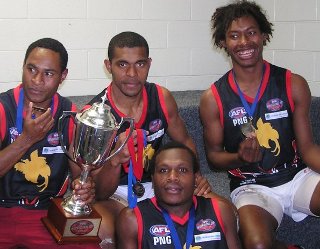 | Papua New Guinea |  |
This page is a quick snapshot of the status of Australian Football in Papua New Guinea. For further information, browse our news items or use the search facility. If you wish to contact football officials from the country, please search our site for links to their leagues or clubs, including in our Atlas. If unsuccessful, we can normally assist with putting people in touch.
Approx population (2009): 6.7 million
National side: Mosquitoes
Governing body: AFLPNG
Primary contact / link: AFL Papua New Guinea
WFN Census (2004): 64 senior teams, 1920 adult players, 8000 juniors (very dependent on exact definition, AFL definition at the time gave 3000)
WFN World Ranking (2008): 2nd
History: PNG was previously a territory of Australia, and Aussie Rules has reportedly been established there since the 1930s or 40s, and experienced rapid growth. As a developing nation with the majority of its population living rurally, the game has struggled to maintain a coherence across the country, though the New Guinea National Football League ran in both Port Moresby and Lae in the 1960s (possibly based very heavily on expat-Australians). In the 1970s the game was strong enough to provide a competitive under 17 team to compete at youth level against Australia (tours of PNG and Australian in 1977) and in 1979 PNG fielded a Teal Cup (Australian Under 17 state championships, pre-cursor to the AFL Under 18 championships). The VFL appointed a full time manager of what was called the PNG Rules Council. The game declined in the 1980s with televised Rugby League leading to that sport's dominance, but the flame of footy was kept alive including with assistance from Cairns, Queensland.
PNG success at the 1995 Arafura Games (Darwin) appeared to capture some AFL interest, and AFL PNG was established with AFL support in 2001 to provide structured development pathways for juniors, with strong connections through AFL Queensland. In 2002 and 2005 the Mosquitoes were runners-up at the International Cup, before winning in 2008. Young PNG players were declared eligible to play in Queensland youth tournaments, and to represent Queensland at Under 16 and Under 18 state level. Numerous senior scholarships were provided in the late 2000s, particularly with Queensland state league clubs, followed by the Gold Coast (pre-AFL entry - Amua Pirika and Stanis Susuve), Essendon (David Meli) and Carlton (Peter Labi) giving young players scholarship opportunities at the highest level.
Outlook (2009): Excellent with players now on AFL lists and a breakthrough debut almost certainly just a few years away, and dozens of Australian state league standard players also coming through. Whether a semi-pro league can be established in PNG or even the very long term dream of an AFL team, will be tied very closely to how well this developing nation progresses economically in the decades ahead.
Other points of interest: The best known AFL footballer of recent PNG descent was triple premiership player Mal Michael. PNG remains the frontrunner to produce the first home grown international AFL player, i.e. someone who got their start in footy in their home country, before being drafted into the AFL. The success of PNG is believed to have been a key in emboldening the AFL to support the development of AFL Oceania, later AFL Asia Pacific, under the guidance of AFL Queensland and AFL PNG stalwart Andrew Cadzow.